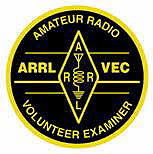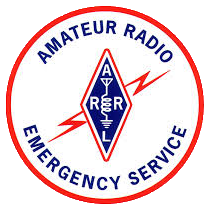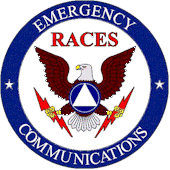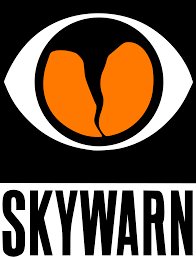NTS and ICS-213 Messages
- Details
- Hits: 190
Note: Images may be clicked for enlarged view
 The National Traffic System (NTS) has provided a means of passing messages (usually referred to as traffic) via Radiograms for almost as long as amateur radio has existed. Before long distance telephone was common, and until the cost of long distance communication was reduced and ultimately eliminated, NTS was used by Amateur Radio operators to communicate around the country and the world, extending the service to fellow citizens and servicemen around the world.
The National Traffic System (NTS) has provided a means of passing messages (usually referred to as traffic) via Radiograms for almost as long as amateur radio has existed. Before long distance telephone was common, and until the cost of long distance communication was reduced and ultimately eliminated, NTS was used by Amateur Radio operators to communicate around the country and the world, extending the service to fellow citizens and servicemen around the world.
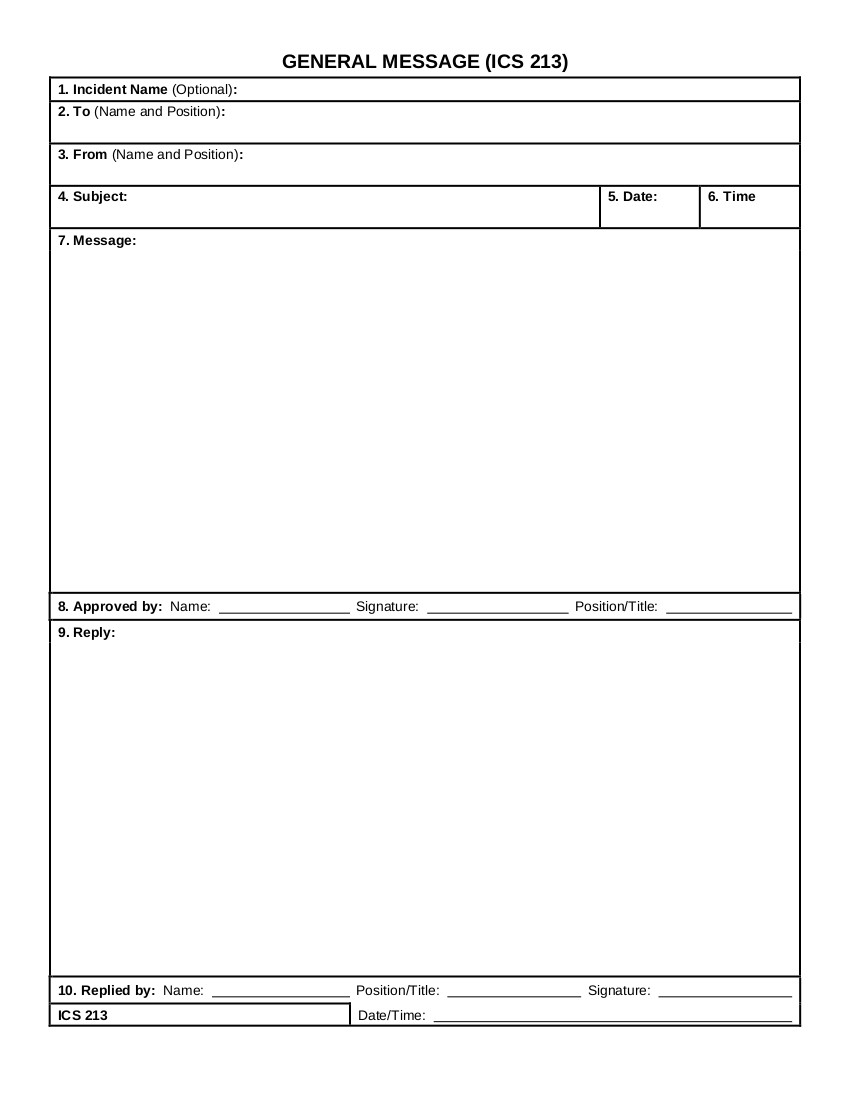 Modern technology has virtually eliminated the need for the passing of routine message traffic, but the NTS and the use of radiograms is still useful during emergencies, especially with the addition of digital modes to our arsenal.
Modern technology has virtually eliminated the need for the passing of routine message traffic, but the NTS and the use of radiograms is still useful during emergencies, especially with the addition of digital modes to our arsenal.
Modern technology isn't the only thing that has impacted our mission. The introduction of the Incident Command System by FEMA, and its almost universal adoption by everyone from local fire departments to NGOs like the Red Cross, has resulted in changes to how ARES does business. Virtually any organization or individual must be familiar with the Incident Command System and have some level of training in it (see ARES Training & FEMA).
When FEMA adopted ICS it developed its own message form, without considering how it would be communicated to and from remote locations. The ICS-213 message form bears similarity to our Radiogram and can be converted into, and communicated via, Radiograms.
 There are a few different ways to adapt the ICS-213 to be compatible with NTS. One way is to transcribe it to a Radiogram, another is to add the Preamble and Postamble to the ICS-213 by hand, and the third is to use an adapted ICS-213/Radiogram hybrid form.
There are a few different ways to adapt the ICS-213 to be compatible with NTS. One way is to transcribe it to a Radiogram, another is to add the Preamble and Postamble to the ICS-213 by hand, and the third is to use an adapted ICS-213/Radiogram hybrid form.
The ICS-213 has enough similarity that adapting the message is fairly straight-forward. The "address" section of the ICS-213 (top section with from, to, and date info) is roughly the same as the Address section of the Radiogram. The Message section, which comes next, is pretty much the same as a Radiogram's Message Text section. Likewise, the Authorized/Signature section of the ICS-213 is similar to the Signature portion of the Radiogram. Looking at the notated ICS-213 you can see how the sections are mapped. All that's left is the preamble of the Radiogram, which is filled out by the originating operator who would be handling the ICS-213 when first presented.
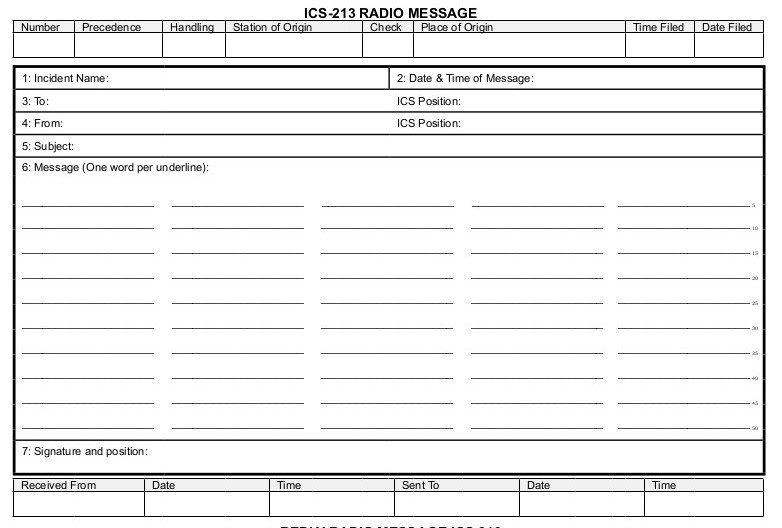 There are a few variants of an "ICS-213 Radiogram", which adds the necessary NTS/Radiogram Preamble and Postamble fields to the ICS-213. Ideally, this form could be used in place of an ICS-213 by the served agency, allowing the Amateur Radio operator to merely fill in the Preamble. If not, then the information could be easily transcribed. This would seem to be the ideal option to me.
There are a few variants of an "ICS-213 Radiogram", which adds the necessary NTS/Radiogram Preamble and Postamble fields to the ICS-213. Ideally, this form could be used in place of an ICS-213 by the served agency, allowing the Amateur Radio operator to merely fill in the Preamble. If not, then the information could be easily transcribed. This would seem to be the ideal option to me.
Another option would be for the operator to just handwrite the Preamble and Postamble information at the top and bottom of the original ICS-213. Since the Preamble and Postamble fields are in consistent order, they could simply be written in that proper order to be properly understood. As a matter of fact, experienced NTS operators can literally copy a Radiogram onto a napkin!
In the end, the exact way the ICS-213 is handled from originator until it is passed to the NTS will be determined by the served agency, with (hopefully) a little input from those of us serving them.
Setting aside the use of Radiograms, Winlink, a digital mode that allows sending and receiving emails even with no internet available, intrinsically handles a variety of ICS forms, including the ICS-213. More on that another time.
Deployable Antenna Support Systems
- Details
- Hits: 568
We've spent a lot of time discussing training for deployment, what personal supplies we'd bring to a deployment, and what radio gear we would bring along, but what to do for antennas?
Yes, roll-up or J-pole antennas have been discussed often for years; to a lesser extent we have discussed low-flying HF (NVIS) antennas. We never know where our deployments may send us, and in many cases trees or other antenna supports may be some distance away, so extra coax and/or rope will be handy in those instances.
Standardized Radio Memories
- Details
- Hits: 1041
ARES, RACES, SATERN, MARS, and virtually every other Amateur Radio organization will have a plan for nets and tactical activities, including a range of frequencies (spanning several bands) to be used for different modes of operation.
Just as there are a range of entities using a range of frequencies across many bands implementing multiple modes, a typical Amateur Radio Operator will own a collection of radios with a variety of differing capabilities. While not all radios will operate across all the bands and operate in all the modes, there is often quite a bit of overlap of functionality.
Prowords
- Details
- Hits: 2719
Like the use of standard phonetics, the use of standard Procedure Words (usually referred to as PROWORDS) helps to ensure the clear conveyance of information between radio operators.
Like phonetics, there is a standard set of prowords used in communications, increasing the probability of understanding even when hearing only a part of the proword during noisy conditions.
Some prowords are more commonly used than others, and some prowords, while more expedient, can be a little confusing because they aren't commonly used in Amateur Radio.
Here are some of the most common prowords you'll hear on formal nets, especially when passing formal traffic:
QRP And Amateur Radio
- Details
- Hits: 0
While many operators tend to operate using the 100W or 200W their radio provides, and yet others use external amplifiers to run hundreds, even more than 1KW, there are others who operate at the other end of the spectrum, 5-10 Watts.
QRP operation is often practiced by operators participating in Parks On The Air (POTA) or Summits On The Air (SOTA), who are often hiking or backpacking their equipment to the operating location, carrying their power source with them. Naturally, packing a Marine Battery would be a bit of a challenge, so smaller and lighter batteries with lower power capacity are used.
Wilderness Protocol and LiTZ
- Details
- Hits: 3620
The Wilderness Protocol, like many Amateur Radio practices, is not part of FCC regulations or law, merely a generally agreed upon practice. The purpose of the protocol is to provide a way for operators outside of repeater range and in need of assistance to make contact with other operators to request assistance.
Although it could, and should, be practiced under any conditions, it was originally designed as a tool for hikers, campers, and those who work in wilderness areas.
Operators, especially those in wilderness areas, would monitor calling frequencies on various bands (146.52 MHz, 52.525, 223.5, 446.0 and 1294.5 MHz) at the top of the hour. Ideally listeners would monitor from a few minutes before
Vanity Call Signs
- Details
- Hits: 2253
Amateur radio operators are issued call signs by the FCC upon qualifying for their Technician license, and have the option to be issued new call signs that reflect their new class when they upgrade to General or Extra. The form of call sign is limited by license class, where higher class of licenses allow simpler/smaller call signs. For instance, a Technician class licensee may be issued something like KX4XTT (often referred to as a two by three, two letters before the number and three after); however an Extra class licensee may have a call sign like W4BK (often referred to as a one by two). There are various call sign formats between these extremes, often limited by license class. You can view the "rules" by going to this link and clicking on "Sequential Call Sign System".
Handheld Radios As Go-Kit
- Details
- Hits: 3100
The most basic “go-kit” item in the Amateur Radio Operator's bag of tricks is the Handheld Transceiver (HT). No, HT doesn't stand for handy-talky. While most of us own several HTs, and they are useful tools, especially when near repeaters, we also know that the HT, out of the box, makes for a pretty poor emergency station. The rubber-ducky antenna and lower voltage batteries often supplied with the radios, along with the lower power output HTs have are challenges to be overcome.
Let's take a look at some things that can improve HT performance:
- Purchase a higher gain antenna for the HT. The original manufacturers equipment (OEM) antenna that came with your HT is little more than a dummy load. Many aftermarket antenna manufacturers make replacement antennas for just about every HT. Talk to others with the same HT as yours and find out what they are using. A step up from that is a mobile antenna or even a base station antenna on a push-up pole. Antenna gain and height are the keys to overcoming marginal operations.
Power Connectors
- Details
- Hits: 13179
One of the interesting things about Amateur Radio is the nearly universal use of PL-259 connectors for base and mobile radio gear, at least that at or below the UHF end of the frequency spectrum. We typically utilize 50ohm cable, even if there are variations of loss across the frequency spectrum, diameter, etc.
One area we see very little standardization, especially across brands, is power connections. Almost all mobile and base gear runs off 12 volts, yet there are a multitude of connectors, having little more than the red for hot and black for ground color coding.
In addition, we will connect that equipment to a variety of sources, some making it obvious which connector is hot and which connector is ground. Others, like car batteries, often require a close look. Also, in some instances the wires are always properly color coded.
Because of these variables we can almost be certain, that if we tinker, change, or rearrange our radio gear very much, we WILL accidentally hook the wires up wrong and let the smoke out of some valuable piece of radio gear.
Page 1 of 7
